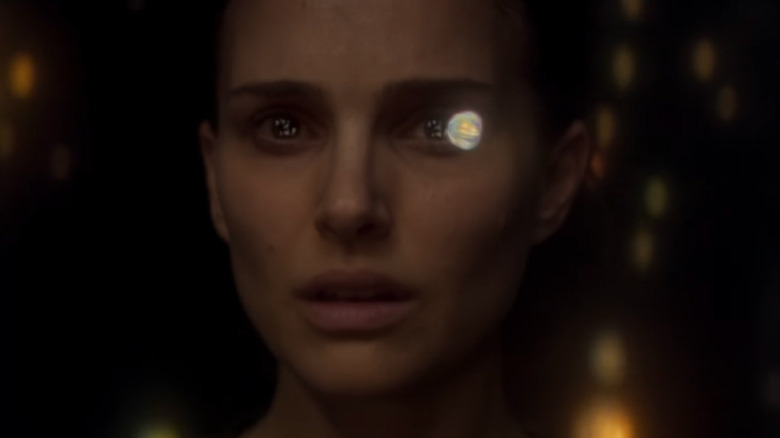Annihilation's Trippy Nature Was A Tricky Problem For Screenwriters To Solve
Alex Garland is no stranger to adapting a novel into a screenplay — before his directorial debut with "Ex Machina," Garland was a novelist himself. He got his first screenwriting credit adapting his debut novel, "The Beach," for the Danny Boyle-directed film of the same name. He also adapted Kazuo Ishiguro's "Never Let Me Go" for the screen, so there's no doubting his grasp on cerebral science fiction. But Jeff VanderMeer's "Annihilation" was a pretty intense departure from the slightly more grounded stories Garland was used to telling — which made its adaptation a unique challenge for the director.
Garland's film doesn't get too caught up in the minutiae of VanderMeer's novel; in fact, they differ from each other in quite a few ways. He might have built a more tangible metaphor out of VanderMeer's elusive Area X (nicknamed The Shimmer in the film), but Garland still captures the essence of "Annihilation" without missing a beat. Many elements of the film still defy our sense of understanding in the same way the source material does, and the process of committing it to the page proved just as elusive for Garland and his team.
Into the unknown
Garland was aware of the novel's abstract quality from the moment he first read it. "I found that reading the book was a weirdly similar experience to having a dream," the director told The Ringer. Rather than intimidate him, it was the metaphysical that drew him to adapting VanderMeer's work. But he discovered pretty quickly that the language used for screenplays was a bit too limited for the scope of the project:
"There was a lot of requirement for unexpected imagery that would be beautiful and maybe disturbing often at the same time, and it didn't give us too many safe spaces to retire to. If you're doing a political thriller that has a car chase in it, there's some familiar grammar that you can latch onto, and then you can find a great stunt supervisor and mess with the grammar and subvert it, but you're on, in some respects, familiar territory."
The world of "Annihilation," however, was decidedly unfamiliar. Describing "psychedelic twilight" — or fleshing out the film's nightmarish amalgamated bear — took both Garland and his crew way out of their comfort zone. Because every element of the Shimmer was so cerebral and intangible, Garland found it difficult to even articulate his ideas for production design and visual effects:
"Sometimes it was difficult, because language is not as precise as we think it is ... [W]hen you're dealing with abstractions, you can feel like you're in a mad loop, where you're saying something as clearly as possible but everyone's looking at you blankly and you just don't know what to do with it, because now you're running out of tools that are available to us for communication."
It's making something new
So how did the "Annihilation" crew finally get on the same page? Ironically, by continuing to talk it through. Garland revealed that some elements of the story "would not be contained in the script," and that some of the most outlandish ideas were born out of a collective, "rolling conversation." If words ultimately failed, Garland and his team would use drawings to get out of their communicative rut:
"What often used to happen, particularly between me and Andrew Whitehurst, the VFX supervisor, and also with the production design team, is we'd have sheets of paper and drawings and we'd just be drawing stuff. Because in a weird way, a drawing can quickly convey something [where] the words would have just never gotten you anywhere."
Keeping things collaborative at every stage made every element of the film like more of a group effort, and perhaps that's why the essence of the novel shines through so clearly. "Annihilation" is, on one level, about the breaking down of self, and how a group of individuals can inform a larger collective. The disparate skills and perspectives of the crew helped to build on ideas that might have felt simple upon first iteration, and even break down concepts that were initially too complex. It's a system that functions almost like the Shimmer itself — terrifying human-animal hybrids not included, of course.


